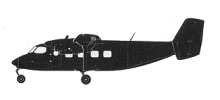Incident Overview

Description
An Antonov 26B cargo plane sustained substantial damage in a forced landing accident Tallinn-lemiste Airport, Estonia following loss of engine power. One of the six occupants was injured. The flight took off from Helsinki-Vantaa Airport, Finland at 09:46 local time. The flight was uneventful until 10:14 hours, 9.5 nm from Tallinn runway 26. When the power levers were retarded to flight idle the crew noticed engine vibration and smelled a smoke in the cockpit. The engine chip detector indicator in the cockpit was lit. After a short discussion about which engine should be shut down the flight engineer shut down the left engine and the captain tried to start the APU to gain more thrust. During the approach the air traffic controller noticed the aircraft deviating from the approach path to the left and notified the crew. The crew was unable to maintain a proper approach path both in lateral and vertical dimensions. The attempts to start the APU engine failed. Visual contact with the runway was established 0.5 nm from the threshold. The aircraft crossed the airport boundary being not configured for landing and with an indicated airspeed (IAS) of 295-300 km/h. The flaps were extended for 10ø over the threshold; the landing gear was lowered after passing the runway threshold and retracted again. The aircraft made a high speed low pass over the runway at an altitude of ca 10-15 feet with the landing gear traveling down and up again. Flaps were extended over the runway. At the end of the runway full power on the right engine was selected, and the aircraft climbed 15-20 feet and started turning left. The crew started retracting flaps and lowered the landing gear. The aircraft crossed the highway at the end of the runway at ca 30 feet, then descended again, colliding with treetops at the lake shore and made a crash-landing on the snow and ice-covered lake waterline. Due to the thick ice the aircraft remained on the ice and slid 151 m on the ice with heading 238ø before coming to a full stop. After the impact the flight engineer shoot down the right engine and power and released all engine fire extinguishers. All persons onboard escaped immediately through the main door. No emergency was declared and despite suggestions from first officer, a go-around was not formally commanded. The airplane gradually sank through the ice after the accident. Causes of the accident: 1. The failure of the left engine lubrication oil system, leading to the failure of the rear compressor bearing and inflight engine failure. 2. The failure of the crew to maintain the approach path and adhere to single engine landing procedures. Factors contributing to the accident: 1. Improper and insufficient crew training, inter alia complete absence of simulator training 2. The lack of effective coordination between crewmembers 3. The failure of the crew to start RU19A-300 (APU) 4. Adverse weather conditions 5. Inadequate company supervision by Polish CAA, consisting in not noticing the lack of flight crew training and companies generally poor safety culture. 6. Inadequate company maintenance practices, leaving preexisting breather duct failure unnoticed.
Primary Cause
Failure of the left engine lubrication oil system, leading to the failure of the rear compressor bearing and subsequent inflight engine failure.Failure of the left engine lubrication oil system, leading to the failure of the rear compressor bearing and subsequent inflight engine failure.Share on:




